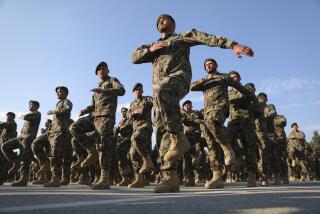76 Suspected Rebels Found Dead, Afghanistan Says
MIANA SHIEN, Afghanistan — The bodies of 76 suspected rebels were found in the nation’s mountainous south, the Defense Ministry said Saturday, bringing to 178 the number of insurgents the Afghan military reported slain in one of the deadliest bombardments by U.S. and Afghan forces since the Taliban fell in 2001.
However, two top Taliban officials reported to be among the enemy forces apparently escaped, an Afghan official said.
U.S. military officers and Afghan officials, meanwhile, met near the mountainous battlefield with dozens of tribal chiefs to urge them to help combat militants still holding out.
Though no major fighting has occurred around Miana Shien district since three days of airstrikes ended Thursday, about 80 rebels are believed to be hiding in the mountains.
The Defense Ministry said Thursday that Mullah Dadullah and Mullah Brader, members of the Taliban leadership council led by the elusive Mullah Mohammed Omar, were surrounded in the operation, but ministry spokesman Mohammed Ishaq Paiman said they apparently got away.
“If they had been killed, we would have found their dead bodies. If they had been arrested, we would recognize them,” he said. “It means they have escaped.”
Another ministry spokesman, Zahir Marad, said that 56 suspected insurgents were captured as security forces pushed farther into the rugged terrain and that troops were still pursuing rebels fleeing on horseback and motorcycle.
“Our forces have collected the bodies of 76 more rebels from the battlefield,” he said, adding that the corpses had been scattered across a wide mountainous area.
The death toll could not be independently confirmed because the fighting occurred in an isolated area about 60 miles northeast of the city of Kandahar.
The U.S. military’s toll of insurgents killed was much lower, at 56. However, spokesman Lt. Col. Jerry O’Hara said this did not necessarily make the government’s figure wrong, because Afghan forces had taken the lead in the operation and U.S.-led coalition troops were finding it hard to count the dead.
“It’s very difficult determining how many died when A-10 planes and other attack aircraft, as well as heavy machine guns, have been used against the enemy,” he said. “Some of the bodies may also have been buried before we could count them.”
About 465 suspected insurgents have been reported killed since March, after snows melted on mountain tracks used by the rebels.
In the same period, 29 U.S. troops, 38 Afghan police and soldiers and 125 civilians have reportedly been killed.
The increase in fighting has reinforced concerns that the Afghan war is widening, rather than winding down. U.S. and Afghan officials warn things could get worse ahead of parliamentary elections scheduled for September.
O’Hara said the purpose of the meeting of about 35 tribal chiefs, the governors of Zabol and Kandahar provinces and U.S. officials was to determine how “we can prevent the Taliban from having any influence” in the region, which was a Taliban stronghold before Afghan and coalition forces attacked the area Tuesday.
Ali Khail, a spokesman for the Zabol governor, said the tribal leaders expressed their support for the battle.
He said Afghan officials promised to build roads and clinics in the impoverished area in exchange for their loyalty.
“The meeting went very well,” he said. “They have promised to help us track down the Taliban.”
More to Read
Sign up for Essential California
The most important California stories and recommendations in your inbox every morning.
You may occasionally receive promotional content from the Los Angeles Times.









